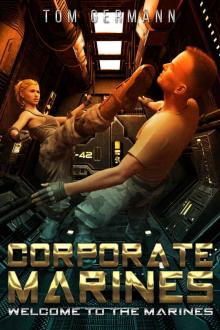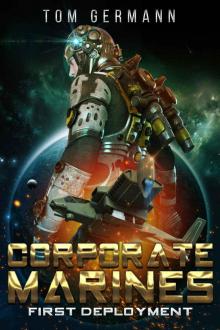- Home
- Tom Germann
First Deployment (Corporate Marines Book 3) Page 5
First Deployment (Corporate Marines Book 3) Read online
Page 5
I nodded yes and he cleared the screen. He smiled. “Good. That’s not what you’re here to learn today, though. I’m going to show you something that is not taught on Earth during your introductory boot camp. Take a close look at these.”
I stepped up closer to Four and looked down at the spare parts he had on the bench. I saw that he had placed down four pistol batteries, a power testing unit, the backup battery, adhesive material, and several other parts that were not from the suit and I had no clue what they were. I looked at him and again, he didn’t give me a chance to speak.
“You recognize everything except for these items, right?” He waved his hand over the parts that I had no clue about. “That’s okay; no one recognizes them unless they have more of a technical background, and that’s rare.”
Again he reached over and touched the screen, bringing up a schematic that included most of the parts I was looking at.
Four smiled hugely. “My young friend, you are going to discover how to make a very nasty electromagnetic pulse bomb. This EMP bomb can be made in the field with just a few parts. I’m teaching you how to make this using three pistol batteries, which is one clip that will be sitting on your armour. There are some other bits that go along with that and will blow your mind when you figure it out. I’m amazed that a lot of civvie kids aren’t in jail. Then again, I don’t know what they teach kids today. . . .”
Four paused for a second and then shook his head. “Let’s carry on, shall we? When you use this, you will knock out the electronics within a relatively small area. In most cases, military-grade electronics are hardened and protected from this sort of attack, so you will have less success against that sort of target. But usually the other side has to suspect that this is coming to effectively defend against it. I’ll take you through how to make a very specific-sized bomb and show you what the effects are. We’ll build it here a few times by hand and then do the same in armour. Finally, we are going to go in sim and use the device and see what happens. You watch and learn. If you have questions, ask immediately. I don’t want to have you miss anything. Let’s begin.”
Four and I spent two hours at the workbench building the same bomb over and over again. The first thing I did was make sure that the batteries we were using were completely drained or were not real. I didn’t want to build something and take part of the ship offline because of a mistake.
I needn’t have worried because the batteries were old, dead ones. I had the feeling that Four was satisfied with how I did as we came toward the end of the hands-on training. I also asked a lot of questions and found out that we only used older batteries.
To make the device, three pistol batteries were used and connected together with the adhesive. The smaller suit battery acts as the charge powering the rest of the device and also as an electronic blasting cap. It was actually straightforward to make the device, but I still had lots of questions about creating this. Why did we only use old batteries past their lifespan? Four explained that laser batteries cost a fortune, so using those at the end of their lifespan made better financial sense. Why only three batteries? With a fully charged trio of batteries, the area of effect could not grow past a certain point so you would know within a few feet how big the affected area would be. Structures would guide this a bit but the circle of effect, while affected by material, acted as a shield and was also a globe. So the effect would be felt through the floor and ceiling, unless there was special shielding in place. It was something to be careful of when on a space station during an operation and section members were operating on different levels of a structure.
I asked if we could use other larger laser batteries for this. Four was pretty clear that we could, but larger batteries could be rebuilt and the area of effect would be bigger and stronger. Using more than three batteries caused issues. As the batteries were older, the exact power that they could still hold was not guaranteed. If more batteries were added, the area of effect tended to fluctuate much more.
After that period of instruction was over, I was off, and with my armour maintained and all the rest of my work done, I studied up on laser weapons before going to sleep. Lasers were different from energy weapons in that the technology was more mature. If we ever developed much better power storage capacity, then lasers would make a huge jump in power. At the same time, energy weapons were just coming out of the land of theory and moving into functional prototypes. It looked like they would be a much more devastating series of weapons one day.
Probably not in my lifetime, though.
After the next day’s activities were all done, I met up with Four in armour and we spent two hours building the same device in every condition possible. The worst was when he deactivated my armour’s power systems. I still had life support, but otherwise I was in a large metal suit that didn’t want to move. Of course, that meant scanners could not pick up any electronic signal. But I was wearing a lot of heavy metal that did not want to budge.
Still, I was able to build the device even with the weight and lack of vision, which was interesting.
I wouldn’t want to do that again, but I felt good that I could if I ever ended up in powered-down armour needing an EMP bomb.
Four seemed pleased again that I was doing this the way he wanted it done. I asked a few questions about the systems and he told me to research more and then ask the questions.
I did more research that night and became even more confused. The information that was available seemed to contradict itself. Lasers were a great system, and they were the worst system ever. In fact, I swear the one researcher would probably have felt better arming soldiers with bows and arrows over laser weapons.
On the third day of my training, we moved into a series of sims.
I built bomb after bomb in offensive and defensive operations. I used them to fry door systems and take out sentry guns. I didn’t use them successfully to take out a Kah-Choo heavy armour suit because it was too heavily shielded and I died fast during that sim. The discharges never looked like much. Sometimes you would see some sparking around the affected items, but that was it. No flash and no bang.
After what felt like days, I finished what Four thought was mandatory. I had passed his training and he felt I was ready.
We were standing in sim and he looked at me. “Good job overall. I know you have questions, and you don’t really believe what you were told about the number of batteries to be used or their age, right?”
I shrugged. “Well, I don’t know; I’ve never experienced it before. I never even knew that we could do this before I met you for the first lesson.”
Four grinned that big grin of his that seemed to show his happiness. “But, you are in a sim. The AI has all the tested parameters in memory for the different systems we work with. Let’s have you use the planetary base scenario.”
Everything around us vanished and then we were back on a planet surrounded by high walls as we stood within a compound of some sort. There were alien soldiers and vehicles all over, frozen as they moved to their defensive positions. Four looked at me. “So what do you want to do now, Eight? Build a bomb.”
I called up the parts and assembled a BIG bomb using heavy laser rifle batteries. I used the full loadout that a sniper would have with them usually. I hooked fifteen batteries together and then Four had the computer place the bomb in different places as he ran different sims. A full section deployed to move in and take out an AI that was in charge of local defences. Every time the bomb detonated, the effect was different. The variation in how large the affected area covered was huge. In fact, in every case the pulse took out most of the section as well as most of the garrison’s electronics.
The second time, I built a bomb out of different-sized batteries and used it on a small research space station. The pulse fried every system on the station almost every time. Even the hardened ones.
So the answer was not to go crazy with the batteries. I
f this needed to be used, then it would be effective in specific and very limited circumstances.
Maybe. I still wasn’t sure so I asked Four. “These are sims that we are watching,” I said. “I don’t think it’s the same as actually deploying and controlling the actions in the sim.”
I had to pause and rethink how I was saying this so it wouldn’t come off the wrong way.
I started again. “The sim is a very powerful computer program using all the options. But it is still evaluating using statistical data. A real individual could make this work. I mean, what if all the data that the AI has is correct, but the input was not completely accurate? Think of the blind spots that we all have.”
I stopped then as Four was considering me. I was hoping I hadn’t alienated another member of the section. I wouldn’t ever be accepted if I had.
Four nodded slowly. “Very good. I see what you are thinking and trying to say. I don’t think that you’re right. Mostly because data is checked in its most basic format. Also, the sims are checked by different AIs and run multiple times.”
That was it. I was done. I should have kept my big mouth shut.
Four shrugged. “It doesn’t mean that the sim is always right, though. Data can be missing, and that is a nasty-ass argument about data, mostly because it’s true. So the answer, at least for now, is to have you go through and act independent. Now, we are not going to actually use real batteries in a test. First, the cost is prohibitive. Second, even with shielding, even the chance that something goes wrong and it blows through the shielded cage means no live action. I don’t want to be drifting in space in a ship where all the electronics have been fried and try to carry out repairs.”
Four smiled at me and there was something nasty there. “We have some time, and this falls within training. You are going to create a section in a sim and you are going to carry out a mission. Let’s do a raid—or would you prefer a defensive scenario?”
Four was offering to let me run with my idea. I shook my head no. “This sort of device would be used offensively so I want to use it in the correct way. A raid or attack.”
He nodded. “You assemble the team. I would use our section, as there is lots of statistical data on how we all operate. That isn’t even really important. You are going to build and use the device. Let’s get this set up and run it tomorrow, then. Will that give you enough time to set up?”
I didn’t even have to think about it. Even with working on armour and other training, I could have this done in seconds. “I can have this ready to run tomorrow. If I send you the data for sync-up half an hour before, will that work?”
Four had that nasty smile again. “Sure. Off you go, then; you have lots of work.”
I ended up carrying out the rest of my day’s work with no holdups. At the end of every training cycle there was some time built in. The expectation from higher was that we would always be pursuing other interests. Only focussing on our combat skills and taking yourself to the highest level of preparedness was good, but no one could hold it without action. So every one of us was expected to have hobbies and other interests. I had seen the system’s directory; I think half of the section was getting a degree.
I hadn’t started that part of the cycle yet, as I was still catching up to the section’s rhythm.
I should have been done in half an hour, tops. I ended up working on the project for hours and missed most of my night’s sleep.
I realized that the data part that I had mentioned could be affecting the AI’s take on what I created. So I went in and manually equipped the section with the hardware and mission orders.
I showed up to Four’s lab on time and walked in. I had uploaded the just-finished data to the system on time. He was sitting at a workstation and nodded to a racked helmet just to the side. “Okay, grab the helmet and have a seat. You’ll be in-sim in a second. I’m going to monitor the feed from here and see how it goes. I won’t be visible in-sim, but I’ll still be tracking you.”
I sat down and put the metal framework on my head.
I didn’t even have time to talk. I was in the sim instantly.
The section was deploying via drop ship and we were coming in fast. The onboard AI gave us the last short tactical update and then we slammed into the ground.
My umbilicals pulled free as I started walking. Three’s had jammed up, given how hard we hit the ground, but the explosive bolts sorted that out in a second.
This was a raid on a Kah-Choo Empire outpost. The justification did not matter, as that fell into the side of politics and business, which I wasn’t supposed to care about. We were the good guys here. Period.
The data stream from the drop ship suddenly exploded with warnings. We were being painted by every targeting system known and a bunch that weren’t.
We assaulted forward. With the drop ship’s AI laying down suppressive fire, all ten of us sprinted for cover ahead. It wasn’t very long at all before hidden defensive systems activated and started firing back.
Anytime you have a ship-mounted weapon versus a defensive weapon site on the ground, the land-based system is going to win. Better armour, dedicated power lines, and the fact that a ship-based system is on a ship and limited in size and number. If you are building a defensive site on a planet and it’s important? You build dozens of weapon systems in the area and have them just sitting there.
On my HUD I could see dozens of incoming missiles. Most, but not all, were targeting the ship. In our area a few medium weapons opened fire on the ship as well.
The AI took out all the missiles heading for us. Proper prioritizing of the Marines first. But the second flight of missiles and a few rail-gun rounds made it through.
Just as we hit the slag heaps, the ship went up behind us. It temporarily overloaded my display and the few incoming missiles veered off. Two teams of two took cover and began firing back with medium weapons. Rocket launchers with backup tri-barrelled projectile weapons that would open medium armour like an egg. The rest of us kept running.
Every second the systems were coming online meant we could penetrate that much farther and faster into their defensive net. They would be able to bring less of their overall firepower against us.
We hit a minefield that used blasting charges; one of the symbols on my HUD disappeared and another went from blue to red. Down but not dead. At least not yet.
The four behind us in support were firing as fast as they could reload.
This was the hardest sim I had ever been in. On the ground for less than forty-five seconds and every weapon system was online in the defensive line. What looked like a full company in medium armour with symbols that I thought meant heavy armour (personal) were coming out of an area off to my left. We had a drop ship destroyed. Two Marines down and pretty much out. The support fire I had loaded for a standard smash-and-grab operation.
Given how they were firing, they would be out of ammo in half a minute for their support weapons, then it was all personal weapons.
I was on point. Up ahead were the outpost structures. Large domed structures would be the cap; we knew this from the little information we had about the Kah-Choo. It was like an iceberg, with the majority of the living and working areas underground.
Ahead of me was what would be a service building. It was smaller, used by maintenance personnel to get in and out with their larger and bulkier service equipment. This would be the perfect way to get in with our larger armour; hopefully, it would allow us access to maintenance tunnels within the complex.
I pulled out a small disposable rocket launcher that was mag-locked to my leg. Quickly I programmed it with a thought and fired it at the large maintenance door ahead of us. The warhead hit and a microsecond later, it exploded, ripping the doors apart. They hadn’t been armoured. At least no more than normal in space.
I kept running at full speed with the other three from my section staying with
me. I leapt through the opening and the other three followed. The last one in had just taken several hits to the leg and the icon was tinged with yellow. Damaged but mostly functional.
We were inside a large open space with lots of lockers and some benches. A few vehicles were parked in here. I assessed things; it was not maintenance, but instead it was some sort of vehicle park.
Outside the firefight was picking up as the enemy company advanced and started firing. A string of heavy shots from a laser punched into the building behind us, searing holes in the side of the structure.
My HUD changed and an access point to down below was highlighted. We started moving toward the hatch. More rounds were starting to hit the wrecked double doors.
My HUD was set for close range, but there was a series of buzzes. Two of the covering team were down and out. The enemy forces had to be putting in a full assault now. We didn’t have long.
The access hatch was an elevator. I pulled up schematics while one of the others sprayed down a specialized explosive charge around the platform. It caused lots of damage, but little blast. What little there was would be directed down, causing more damage. The other two were pulling out our rappelling wire and joining them both together.

 The Teddy Bear Stories - Teddy Bear Discrimination
The Teddy Bear Stories - Teddy Bear Discrimination Star Traders (Corporate Marines Book 3)
Star Traders (Corporate Marines Book 3) The Service Centre (Zombie Transference Book 1)
The Service Centre (Zombie Transference Book 1) Video Game Recruiting (Corporate Marines Book 1)
Video Game Recruiting (Corporate Marines Book 1) Welcome to the Marines (Corporate Marines Book 2)
Welcome to the Marines (Corporate Marines Book 2) First Deployment (Corporate Marines Book 3)
First Deployment (Corporate Marines Book 3) Outbreak: A Zombie Transference Short Story Prequel
Outbreak: A Zombie Transference Short Story Prequel